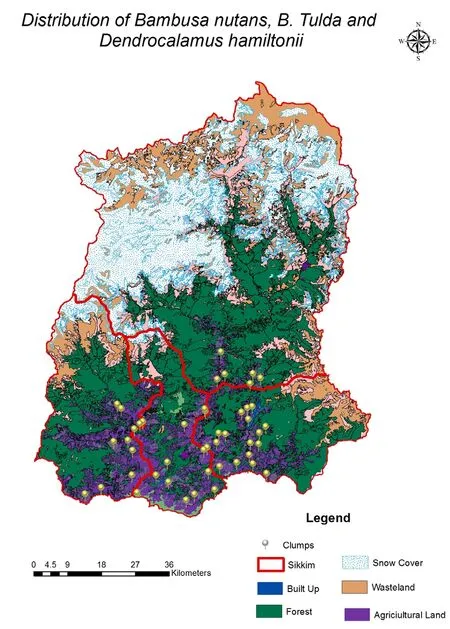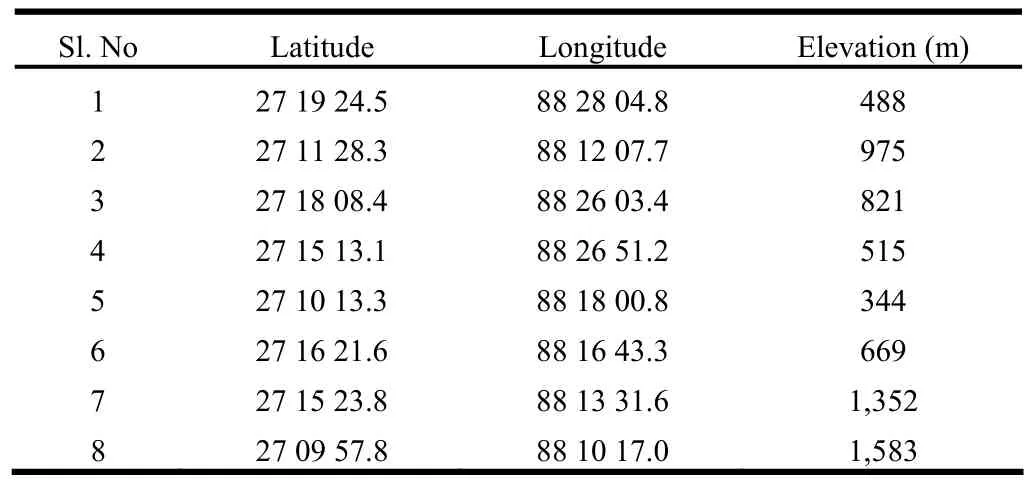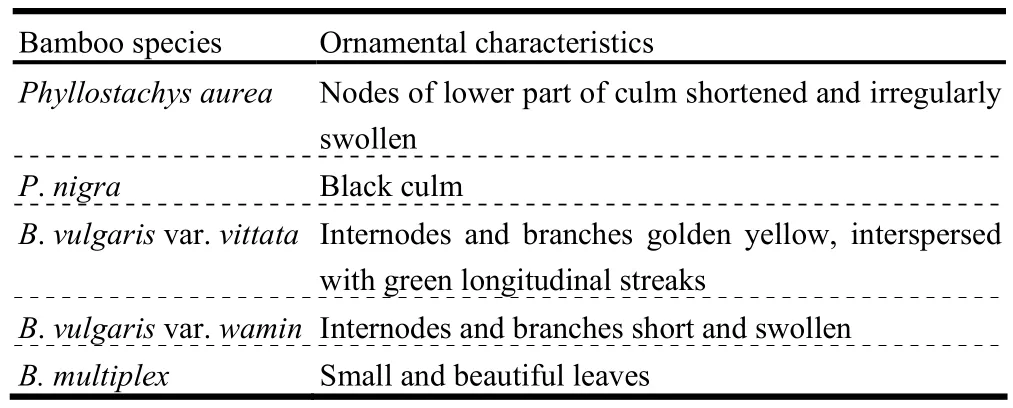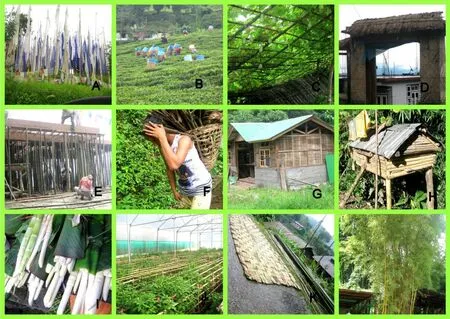Bamboo resources of Sikkim Himalaya: diversity, distribution and utilization
2014-09-06DeoKumarTamangDineshDhakalShrestha
Deo Kumar Tamang · Dinesh Dhakal · D. G. Shrestha
ORIGINAL PAPER
Bamboo resources of Sikkim Himalaya: diversity, distribution and utilization
Deo Kumar Tamang · Dinesh Dhakal · D. G. Shrestha
Received: 2013-04-04; Accepted: 2013-05-03
© Northeast Forestry University and Springer-Verlag Berlin Heidelberg 2014
We recorded 8 genera and over 30 species of bamboo in Sikkim of the reported 23 genera and 125 species in India. Thirty percent of bamboo species were recorded in tropical forests (0–900 m), 40% of species in sub-tropical forests (900–1,800 m), 17% of species in temperate forests (1,800–2,700 m), 9% of species in sub-alpine forests (2,700–3,500 m) and 4% of species in alpine vegetation (3,500–4,500 m). Bamboo is used for various purposes and its versatility qualifies it to be a multiple-use alternative to timber, food for villagers and for tribal in particular. Bamboo is also equally important to Red Panda (Ailurus fulgens), the state animal of Sikkim. We develop a list of bamboos occurring in Sikkim with their vernacular names, distributions and uses in the Himalayan state. However, more extensive study is required to fully describe the bamboo diversity of the Himalayan state.
bamboo, Dendrocalamus, diversity, uses, Sikkim
Introduction
Throughout the world around 75 genera and 1,250 species of bamboo are known to exist (Yang et al. 2004). India has the second largest area of bamboo forest after China (Rai and Chauhan 1998) and it ranks third in bamboo species diversity i.e. next to China and Japan (Bhatt et al. 2003; Lobovikov et al. 2005). In India, there are around 125 bamboo species of 23 genera (Tewari 1992; Varmah and Bahadur 1980).
About 66% of the growing stock is concentrated in the northeastern states of the country (Hore 1998; Adkoli 2002). According to Dransfield (1992), bamboo occurs in the latitudinal range of 46o N to 47o S and elevational range of 0−4,000 masl, covering tropical, subtropical, temperate and alpine regions. Bamboo is one of the most important forest resources in Sikkim. Bamboos are distributed widely throughout Sikkim. Bamboo is usually found in the moist valleys, along the streams, low hill slopes of southern part, moist deciduous forests, wet temperate forests and sub-alpine coniferous forest of the state. Its wide range of uses and versatility qualifies it to be a multiple-use alternative to timber, food for the rural poor and for tribal groups in particular.
As per the growth habits, two types (due to different kind of rhizomes) of bamboos are found. Clumping or clump-forming bamboos are called sympodial or pachymorph. Running or non-clump forming bamboos are called monopodial or leptomorph (Uchimura 1980; McClure 1966; Wong 1995). Monopodial bamboos spread by rhizomes that sometimes emerge far from the parent plant. Most bamboos of this type are erect and long. Sympodial bamboos have short roots, are genetically incapable of expanding more than few inches a year, and form discrete clumps.
In all bamboos, the sheaths carry distinctive characters (Robert et al. 1961) that are for identification (Fig. 1). Bamboo is used for house construction, scaffolding, ladders, mats, baskets, fencing, garden support, fodder, fishing rods, walking sticks, tool- handles, pipes, toys, handicrafts etc., and for several other articles of everyday use. The young tender shoots of several bamboos are eaten as vegetables (Bhatt 2003; Tamang and Tamang 2009). Roberts (1992), listed only five mammals, viz. red panda, giant panda, two bamboo rats (one in China and another in Brazil), and a small lemur, that eat bamboo.
The lesser known bamboo species of Sikkim have not been studied in terms of distribution or their uses. The present study aimed at describing distribution, diversity and uses of bamboos of Sikkim thorough literature review and field surveys. But there is a need for additional inventory and study of population density for utilization and conservation purposes.

Fig. 1: Culm sheaths of different bamboo species
Materials and methods
Study area
Sikkim is a landlocked state located in the eastern Himalayan region and covers 7,096 km2area. Sikkim lies between 27°04′−28°07′ N and 88°00′−88°55′ E. It is bounded by Nepal on the west, Tibet on the north, Bhutan on the east and the Indian state of West Bengal on the south. Sikkim is recognized as one of the“Biodiversity Hot Spots” in the world. Lepchas, Bhutias, Limboos and Nepalis are the main ethnic groups of Sikkim. The forest cover of the state, based on interpretation of satellite data of December 2008, was 3,359 km2or 47% of the state’s geographical area (FSI 2011).
The elevation zone at 300 to 8,000 masl is comprised mainly of forest covered hills and snow covered areas. The vegetation of Sikkim has been categorized into six forest zones based on elevation (Khoshoo 1992): tropical evergreen forest (up to 900 m), sub – tropical forest (900–1,800 m), temperate forest (1,800–2,700 m), sub-alpine forest (2,700–3,500 m), alpine vegetation (3,500–4,500 m) and alpine deserts (>4,500 m).
Sikkim is drained by perennial rivers, which merge into two prominent rivers, Teesta and Rangit. River Rangit is a tributary of Teesta and joins it at Melli, the boundary between Sikkim and West Bengal. The state of Sikkim is divided into four districts, viz. East, West, South and North Districts.
Methods
Information presented here is largely based on field investigations covering almost one year from April 2012 to January 2013. Bamboos were recorded in five of the six forest zones listed above: tropical (0−900 m), sub-tropical (900–1,800 m), temperate (1,800–2,700 m), sub-alpine forests (2,700–3,500 m) and alpine vegetation (3,500–4,500 m). The identification of bamboos was made using identification manuals, taxonomical keys and later with the help of experts. During field surveys, local residents provided important information on bamboo utilization and classification.
We carried out field surveys, to record information on bamboo habitats, rhizome types, culm characteristics, culm sheaths, leaves and other species in surroundings areas. We also collated detailed information on local names, characteristics used to identify species, utilization and distribution. Specimens were collected of species that could not be identified during field surveys, and these were later identified with the help of an expert.
We reviewed the work of work of Gamble (1902), Hooker (1896), Brandis (1906) and Noltie (2000) on bamboos of Sikkim.
In “Flora of British India”, Hooker (1896) has mentioned 13 species of bamboo. Gamble (1902), in “A Manual of Indian Timber”, listed 18 species of bamboo. In “Indian Trees” by Brandis (1906), 13 species of bamboos from Sikkim are recorded. In “Flora of Bhutan”, Noltie (2000) has mentioned about 14species of bamboo.
Results
Diversity and distribution
During field survey and with reference to the literature, a total of 30 bamboo species of 8 genera were recorded (Table 1). The genera of bamboos we recorded in Sikkim were Arundinaria, Bambusa, Dendrocalamus, Melocanna, Phyllostachys, Sinarundinaria, Schizostachyum, and Thamnocalamus. Sub-tropical forest had the greatest bamboo species richness with 28 species, followed by tropical forest (21), temperate forest (12), sub-alpine forest (6) and alpine vegetation (3). Bambusa nutans, Bambusa tulda, Dendrocalamus hamiltonii var. hamiltonii, D. hamiltonii var. edulis, Dendrocalamus patellaris, Sinarundinaria hookeriana and Sinarundinaria maling were found in all four districts.

Table 1: List of species recorded from Sikkim and their distribution
Bamboos usually grow with other species (Table 2).

Table 2: Other species associated with bamboos
Arundinaria sp, Sinarundinaria sp mainly cover the northern part of Sikkim and, Phyllostachys sp, Bambusa sp, Dendrocalamus sp, which occur over extensive areas are found in lower hill forests. Cultivated bamboos are also found in the agricultural land areas, roadsides, private and government Khasmal areas (“khasmal forest” means any forest land settled and set aside by the Government for meeting the bonafide domestic need of timber, firewood and fodder of the adjoining villages).
Eight genera of bamboos were recorded in Sikkim. The most common species were Bambusa nutans, B. tulda, Dendrocalamus hamiltonii, and Sinarundinaria hookeriana. The geographical distribution of a bamboo is greatly influenced by human actions (Holttum 1958). This explains why B. nutans, B. tulda and D. hamiltonii were common to areas all over the state near human settlements (Table 3). These three species are cultivated mostly in agricultural areas (Fig. 2). In many places Bambusa nutans and Dendrocalamus hamiltonii occured sympatrically (Table 4).

Table 3: Location of three commonly found bamboo species (Bambusa nutans, Dendrocalmus hamiltonii and Bambusa tulda)

Fig. 2: Distribution of three commonly found bamboos (Bambusa nutans, B. tulda and Dendrocalamus hamiltonii) of Sikkim

Table 4: Locations: where Bambusa nutans and Dendrocalamus hamiltonii grew sympatrically.
Of 30 bamboo species recorded in Sikkim, 27 species of 6 genera (90%) are sympodial and 3 species of 2 genera (10%) are monopodial. Table 5 shows the monopodial and sympodial genera found in Sikkim.
Uses of bamboo in Sikkim
Bamboos are used for various purposes and their great versatility qualifies bamboo to be a multiple-use alternative to - timber, food for the rural poor and for tribal groups in particular (Fig. 3). In Sikkim, bamboo culms are used for religious rituals like for hoisting prayer flags. They provide raw materials for scaffolding in building construction and in rural areas small dwelling huts are also constructed using bamboos. Some species are used for making mats, fishing rods, baskets, bows and arrows and for making furniture. Bamboos are also used in making bridges in the rural areas, for farmland fencing materials, as fodder for cattle, and young shoots are eaten as a vegetable. Species of bamboo like Dendrocalamus hamiltonii, Arundinaria sp., Cephalostachyum capitatum are relished by locals as vegetables and sold in large quantities in markets (Sundriyal et al. 1998). Even young shoots are preserved as canned food by processing them into pickle. It is also used in making a traditional hat of the Lepcha ethnic group (a Sumok thyaktuk), the oldest form of craft made by the Lepcha tribe in the state (Lepcha 2012). Apart from these uses, bamboos are also used to make vessels to carry milk and water, in construction of walls, floors and roofs, and to build trellises for agricultural and ornamental plants (Table 6). Bamboo species are not important only to humans, but many forest animals also depend on bamboos. Species such as Red Panda, the “State animal” of Sikkim are totally dependent on a few species of bamboos as forage. Red Panda (Ailurus fulgens) feeds mainly on bamboo leaves and occupies dense bamboo forests (Wei et al. 1999; Wei et al. 2000; Pradhan et al. 2001; Yonzon and Hunter 1991; Panthi et al. 2012; Johnson et al. 1988; Reid et al. 1991). Area of bamboo cover, bamboo height and canopy cover are important habitat components in sites used by Red Panda.

Table 5: Genera, species and rhizome types of bamboos in Sikkim

Table 6: Ornamental uses
Red Panda diet consists chiefly of bamboo leaves and both species of bamboo, Arundinaria maling and A. aristata are eaten. The diet of bamboo is supplemented by seasonal fruits and bamboo shoots (Pradhan 2001). Species like Bambusa nutans and Sinarundinaria microphylla are used as medicinal plants. Root paste of Bambusa nutans is used to cure ring worm and the paste of the culm of Sinarundinaria microphylla is used to treat wounds (Sharma and Sharma 2010). Some uses of bamboo are shown in Fig. 3 from A to L.

Fig. 4: Some uses of bamboo. A: Supporting a Prayer flags. B: Basket (Doko) used in the tea garden; C: Support to creeper plants; D: A gate made of a bamboo; E: Bamboo Scaffolding; F: Basket (Doko) used for carrying wood; G: Used in the construction of a house; H: Shelter for small animals; I: Young shoots used as a vegetable; J: Support to creeper agricultural plants; K: Mat (Chitra) made from a bamboo culm; L: Used as an ornamental plant.
Conclusion
We recorded around 30 species of bamboo in Sikkim, but more detailed study and field study are required to further define the bamboo resources of the state. Of 30 bamboo species recorded in Sikkim, 30% were found in tropical forest, 40% in sub-tropical forest, 17% in temperate forest, 9% in sub-alpine forest and 4% in alpine vegetation (Fig. 4). Six genera of bamboos in Sikkim are sympodial (27 of 30 species) and 2 genera are monopodial (3 species). Dendrocalamus was represented by the most species (8), followed by Bambusa and Sinarundinaria (6 each). Schizostachyum was represented by 5 species, Phyllostachys by 2 and Arundinaria, Melocanna and Thamnocalamus by 1 species. More detailed study is required to further describe the bamboo diversity of Sikkim (Fig. 5).

Fig. 4: Percentage of bamboo species in different elevations

Fig. 6: Number of species in each genera
Acknowledgements
The authors wish to express their sincere thanks to Mrs Smrita Pradhan and Mr Sushen Pradhan from Bioinformatics Centre, Sikkim State Council of Science and Technology and entire staff of Sikkim State Remote Sensing Application Center, for encouragement and support during the writing of this paper. The help rendered by Mr Nima Dorjee Lepcha, Graduate Teacher and Miss Sambhawana Gurung, Consultant during the study is gratefully acknowledged.
Adkoli NS. 2002. Indian bamboos in early 21st century. In: Kumar A, Rao IVR, Sastry C (eds), Bamboo for sustainable Development, Proceedings of the Vth International Bamboo Congress and the VIth International Bamboo Workshop. San José, Costa Rica, 2−6 November 1998, pp. 17−25.
Bhatt BP, Singha LB, Singh K, Sachan MS. 2003. Some commercial edible bamboo species of North East India: Production, Indigenous uses, Cost-Benefit and management strategies. The Journal of the American Bamboo Society, 17(1): 4−20.
Boontawee B. 1988. Status of bamboo research and development in Thailand. In: Proceedings of the International Bamboo workshop held in Cochin, India, 14−18 November. Kerala Forest Research Institute and International Development Research Center, Canada, p. 1214.
Brandis D. 1906. Indian Trees: An Account of Trees, Shrubs, Woody Climbers, bamboos and Palms Indigenous or Commonly Cultivated in the British India Empire. London: A. Constable.
Dransfield S. 1992. The Bamboos of Sabah. Sabah Forest Report, No. 14. Malaysia.
FSI (Forest Survey of India). 2011. India State of Forest Report 2011. Sikkim, pp. 214–218.
Gamble JS. 1902. A Manual of Indian Timbers: An Account of the Growth, Distribution and Uses of the Trees and Shrubs of India and Ceylon with Descriptions of Their Wood-Structure. London: S. Low, Marston & Co. Ltd.
Holttum RE. 1958. The bamboos of the Malay Peninsula. The Gardens’ Bulletin, Singapore, 16: 1−135.
Hooker JD. 1896. Flora of British India, vol. VII. London: Forgotten Books, p. 724.
Hore DK. 1998. Genetic resources among bamboos of Northeastern India. Journal of Economic and Taxonomic Botany, 22(1): 173−181.
Johnson K, Schaller G, Hu J. 1988. Comparative behavior of red and giant pandas in Wolong Reserve, China. Journal of Mammalogy, 69(3): 552–564.
Khoshoo TN. 1992. Plant Diversity in the Himalaya: Conservation and Utilization. G.B. Pant Memorial Lecture: III. Kosi-Katarmal, Almora: G.B. Pant Institute of Himalayan Environment and Development.
Lepcha SR, Gurung R, Arrawatia ML. 2012. Traditional Lepcha craft Sumok-thyaktuk (Lepcha Hat) and its conservation in Dzongu Tribal Reserved Area (DTRA), Sikkim, India. Indian Journal of Traditional Knowledge, 11(3): 537−541.
Lobovikov M, Paudel S, Piazza M, Ren H, Wu JQ. 2005. World Bamboo Resources. A Thematic Study Prepared in the Framework of the Global Forest Resources Assessment 2005. Rome: Food and Agriculture Organization of the United Nations.
McClure FA. 1966. The Bamboos−A Fresh Perspective. Cambridge, Massachusetts: Harvard University Press.
Noltie HJ. 2000. Flora of Bhutan: Including a Record of Plants from Sikkim and Darjeeling Volume 3, Part 2. Edinburgh: Royal Botanical Garden, Edinburgh, and Royal Government of Bhutan.
Panthi S, Aryal A, Raubenheimer D, Lord J, Adhikari B. 2012. Summer Diet and Distribution of the Red Panda (Ailurus fulgens fulgens) in Dhorpatan Hunting Reserve, Nepal. Zoological Studies, 51(5): 701–709.
Pradhan S, Saha GK, Khan JA. 2001. Ecology of the red panda (Ailurus fulgens) in the Singhalila National Park, Darjeeling, India. Biological Conservation, 98(1): 11−18.
Pradhan S, Saha GK, Khan JA. 2001. Food habits of the red panda, Ailurus fulgens in the Singhalila National Park, Darjeeling, India. Journal of Bombay Natural History Society, 98(2): 224−230.
Rai SN, Chauhan KVS. 1998. Distribution and growing stock of bamboos in India. Indian Forester, 124(2): 89−98.
Reid DG, Hu J, Huang Y. 1991. Ecology of the Red Panda Ailurus fulgens in the Wolong Reserve, China. Journal of Zoology, 225(3): 347–364.
Robert AY, Joseph RH. 1961. Bamboo in the United States: Description, Culture, and Utilization. States Department of Agriculture Crops Research Division, Agricultural Research Service.
Roberts M. 1992. Red Panda: The fire cat. ZooGoer, 21(2).
Sharma TK, Sharma S. 2010. Medical plants of Sikkim. Gangtok: Sharma and Sharma Publication, p. 1−6.
Sundriyal M, Sundriyal RC, Sharma E, Purohit AN. 1998. Wild edibles and other useful plants from the Sikkim Himalaya, India. Oecologia Montana, 7: 43–54.
Tamang B, Tamang JP. 2009. Traditional knowledge of bio preservation of perishable vegetable and bamboo shoots in Northeast India as food resources. Indian Journal of Traditional Knowledge, 8(1): 89−95.
Tewari DN. 1992. A monograph of Bamboo. Dehradun, India: International Book Distributors, p. 495.
Uchimura E. 1980. Bamboo cultivation. In: Bamboo Research in Asia, Proceeding of Workshop Held in Singapore 28-30 May 1980.
Varmah JC, Bahadur KN. 1980. Country report and status of research on bamboos in India (Indian Forest Record). Botany, 6(1): 1−28.
Wei FW, Feng ZJ, Wang ZW, Hu J. 1999. Current distribution, status and conservation of wild red pandas Ailurus fulgens in China. Biological Conservation, 89(3): 285−291.
Wei FW, Feng ZJ, Wang ZW, Hu J. 2000. Habitat use and separation between the giant panda and the red panda. Journal of Mammalogy, 80(2): 448−455.
Wong KM. 1995. The Bamboos of Peninsular Malaysia. Malayan Forest Record, No. 41.
Yang YM, Wang KL, Pei SJ, Hao JM. 2004. Bamboo diversity and traditional uses in Yunnan, China. Mountain Research and Development, 24(2): 157−165.
Yonzon P, Hunter ML. 1991. Conservation of the red panda Ailurus fulgens. Biological Conservation, 57(1): 1–11.
DOI 10.1007/s11676-014-0540-4
Project funding: This work was financially supported by the Horticulture and Cash Crop Development Department, Government of Sikkim, under National Bamboo Mission (NBM).
The online version is available at http://www.springerlink.com
Sikkim State Remote Sensing Application Centre, Sikkim State Council of Science and Technology, Development Area, Gangtok 737101, Sikkim. Phone: +91 8900403760
E-mail: deo123.kumar@gmail.com
Corresponding editor: Yu Lei
杂志排行
Journal of Forestry Research的其它文章
- Growth and yield of two grain crops on sites former covered with eucalypt plantations in Koga Watershed, northwestern Ethiopia
- Carbon stock in Korean larch plantations along a chronosequence in the Lesser Khingan Mountains, China
- Biomass accumulation and nutrient uptake of 16 riparian woody plant species in Northeast China
- Cloning and sequence analysis of nine novel MYB genes in Taxodiaceae plants
- Genetic and morphological variation in natural teak (Tectona grandis) populations of the Western Ghats in Southern India
- Improved salt tolerance of Populus davidiana × P. bolleana overexpressed LEA from Tamarix androssowii
